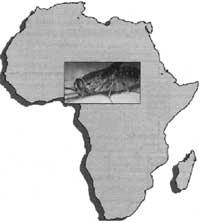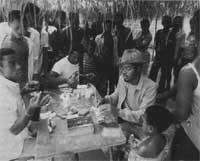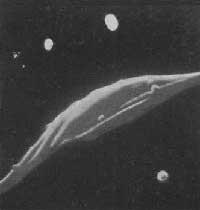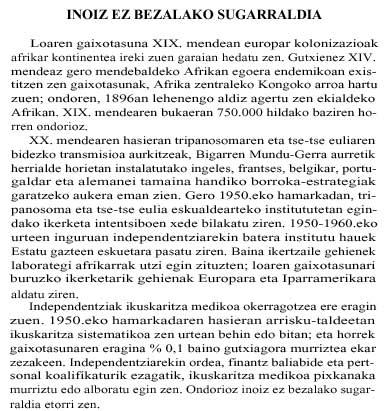Sleep disease. How to save Africa?

Tripanosoma, which causes sleep disease, is a parasite known since the beginning of the century. Extracellular protozoan. It has a scourge that facilitates the delocalization of biological and intercellular fluids. The Tse-tse or Glossina morsitans fly is the one that, after the absorption of the affected blood, transmits the trypanosome to man. Before reaching the infectious situation, tripanosoma develops in the tse-tse fly in a complex cycle of 15-30 days.
On the other hand, there are few infected tse-tse flies, about a thousand. But every three days they transmit the parasite in each blood intake, which occurs during the six months that it survives. They feed from one person to another, which explains the family or community influence (influence the same place of activity). The homes of the Tse tse fly are very numerous, especially in the savannah, in the water and bathing areas and in the forest areas.
In fact, sleep diseases are two: a chronicle, transmitted by Gambian Tripanosoma (extended in Central and Western Africa) and another severe, caused by Rhodesian Tripanosoma and punishing East Africa and Southern Africa. Morphologically both parasites are the same. They reproduce in the blood of the affected people, then invade the nodes and finally attack the nervous system causing incurable lesions.
But man is not the only deposit of trypanosoma. For a long time we know that rhodesiana Tripanosoma infects wild and domestic animals. And in recent studies in West Africa it is concluded that pork and also dog are deposits of Gambian Tripanosoma.

Sleep disease is easily cured if contracted in time; that is, when the parasite is dispersed by the blood and the nodes. The drug used to cure the disease, pentamidine, has been ruled out for the benefit of prophylaxis. Unfortunately, the initial signs of the disease are not very accurate.
Many times the adult of the infected fly is not perceived and the attacked person suffers symptoms similar to those of the flu. In the second phase of the disease, the parasite captures the brain and serious neurological symptoms appear. The patient sounds like his mood changes and suffers chills and uncontrollable movements. Later it becomes progressively and enters a coma state more or less. The disease reaches the heart at acute levels and evolves for several weeks until death.
The American society Marion Merrel Dow has recently released a new drug called Ornidyl. This substance blocks the enzyme essential for the proliferation of the parasite (ornithine decarboxylase). This reproduction in the nervous system is the cause of the disease and sometimes the cause of death. Research on this drug has been carried out mainly in France. Merrel Dow Research Institute of Strasburg.
Before Ornidyla, all the medications that were to treat the nervous phase of the disease had important side effects (venous thrombosis, minor, eruptions, etc. ). From 1 to 5% of cases treated with melarsoprola (a derivative of arsenic) die. In addition to its toxicity, it is often ineffective; patients resistant to this drug are increasingly numerous. The ornidyla has also been proven effective in the neuro logical phase.
The only problem is that for two weeks, two to four times a day, it is injected intravenously. It will be administered in specialized centers, that is, in places not accessible to the population as an enderotic focus of the disease. In addition, the two-week treatment costs about 140 dollars and it does not seem that the affected countries can buy it without outside help.
The "vitality" of sleep disease is largely explained by the ability of tripanosome to disguise its identity. It is transformed again and again by altering the structure of the glycoproteins that surround it. To do this he uses a trick: he does not teach them at once, but after the smoothie, the DNA that encode the glycoproteins, that is, his genetic material. When the organism is contaminated, the immune system generates antibodies for the elimination of parasites, but survivors have the possibility of forming a new identity and while the immune system creates other antibodies have time to reproduce.

More than a thousand parasitic forms, therefore, are not censored, which eliminates all the possibilities of finding vaccines. Faced with this strategy, the immune system can act against the tissues of the organism. Research is not very advanced, these mechanisms are not well known, but they are probably the origin of the lesions that sleep disease causes in the heart and brain.
Is the immune system completely unarmed before tripanosoma? There is no formal proof of self-healing. However, when several affected people have reappeared after hiding for months, it has been seen that they were not carriers of the virus. There is one clear thing: there are people who tolerate trypanosoma. Although the parasite is in your blood, for years they show no clinical signs. However, these carriers are dangerous: you have to find them to break the transmitter chain.
WHO, together with the World Bank, accompanied him in 1975 with a broad research programme on tropical diseases. The work on sleep disease has an annual budget of 1.4 million dollars. In the last decade, $16 million has been used worldwide to develop 400 projects. These investigations may open up new therapeutic pathways, but for the moment they are in the initiation phase. Among these works, carried out by the biochemistry unit of normal and pathological proteins of the Inserm de Lille, have helped to better understand the anchoring points of glycoproteins in the surface of the tripanosoma. Those made by the Dutch university of Groningen have allowed to know better the structure of these molecules. Tripanosoma has become a normal laboratory model in the control studies of genetic expression.
The implementation of new serological tests allows, in theory, a mass follow-up. But only in theory, because the affected population needs to benefit from it. Sleeping sickness is a rural disease that requires to move to the places where the population is, which means a great mobility and continuity. The sanitary inspection cannot be delegated only to the local doctor. Specialized national teams, cars in good state, means of payment of nurses, etc.

All this coupled with the experimentation of various ways against the tse-tse fly. It is worth mentioning the dispersion of insecticides by plane or helicopter. But its ecological consequences are no joke and this route is only used in exceptional cases. The simplest and most effective method is to use traps. The Orstom researchers have used this cheap and non-polluting capture pathway. Electric blue traps are used which will attract the tse-tse fly by rubbing with insecticide.
In Uganda, in 1989, in the region of Busoga, in 2,850 square kilometers, 8,000 traps of this type were installed. The number of flies tse-tse decreased by 98% in nine weeks and the sun was sleeping 80% in three months. However, these instruments must be kept constantly so that the vegetation does not hide them. In the best of cases, the specialized teams that come to inform themselves become responsible to the population.
Even more encouraging are insecticide-soaked screens. These tools, devised by Claude Laveissiére de Orstom, allow the direct participation of the local population, which can be taken. The first to be used in the Bics and before the end of the year was in Uganda and Congo. Recently researchers at the University of Oxford thought to use indicators of vegetation obtained via satellite to try to predict the environments in which the tse-tse fly operates. They do not live and do not reproduce if the relative humidity is not 50 to 85% (according to species).
Based on satellite images used for weather forecasts, the vegetation indices of several established years have been systematically analysed, which have also allowed to study inaccessible places in the Land Rover. Since vegetation is closely related to the degree of humidity, which determines the mortality and fertility of flies, it is possible to foresee areas with a high degree of survival. Thus, some areas of the north of the Bolicos have been identified. At this time, a map of risk areas is expected to be made.

However, there is no reason to be burdened. All fronts (previous studies, anti-scholarship struggle, education, etc.) Only systematic and regular surveillance will cause a decrease in the frequency of ender in the population at acceptable levels (around 2%). But given the problems facing Africa, it is difficult to find a way out of this problem. Sleep disease is just one more calamity.
Most economies are deteriorated and there are problems of higher priority. To start with, little nutrition. Zairen, for example, has passed the frequency of sleep disease from 0.01% to 12% in some years and 18% in some regions. The war has not helped anything. Struggles, as in Sudan, have made the situation even more dramatic. This country has less than 5% of the population subjected to sanitary inspection. In 1990 the Sudanese were able to escape their country, with whom they carried the disease to the northwest of Uganda: In the Moyo hospital, of the 425 patients studied in the first quarter of 1990, 251 nasal and 166 repatriated from Sudan were detected.
According to the latest estimates made by WHO, prevention, detection and treatment of sleep disease is estimated at $10,000 per year per 100,000 people. A budget of approximately 13 or 14 million euros per year would be needed to serve 12 or 13 million people at risk. Six of the eleven most attacked African countries have a gross national product of $500 per inhabitant and their annual health budget is less than $10 per inhabitant. Health and poverty are, therefore, absolutely incompatible...






